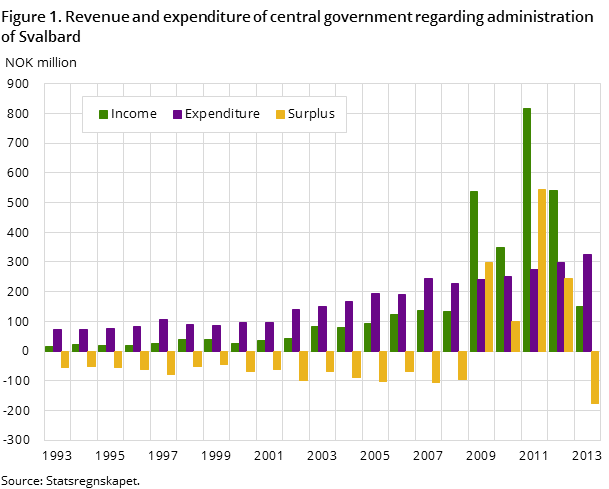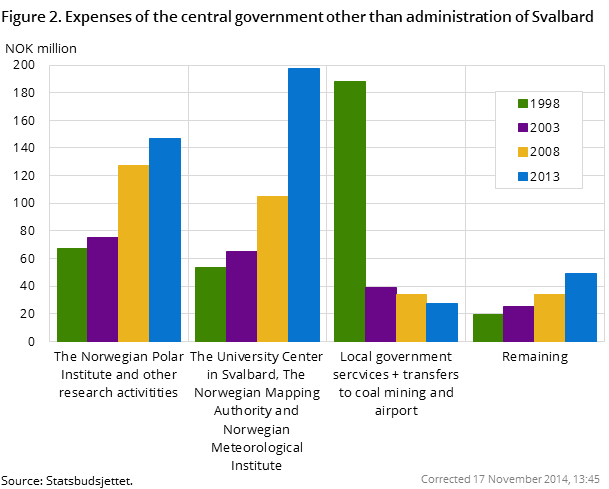Content
Published:
This is an archived release.
Different public sector on Svalbard
The percentage of the total workforce employed in the public sector is about the same on Svalbard as in mainland Norway.
| 2012 | 2013 | |
|---|---|---|
| Corrected 17 November 2014 at 12:50 am. | ||
| Share of total employment on Svalbard | ||
| Central government (incl. social security funds) | 12.2 | 12.8 |
| County authority | 0.0 | 0.0 |
| Municipalities | 13.5 | 12.7 |
| Enterprises owned by central government | 33.4 | 31.0 |
| Enterprises owned by local government | 0.0 | 0.0 |
| Private sector | 41.0 | 43.5 |


Large public sector employers, such as The Armed Forces, The Norwegian Public Roads Administration, the Norwegian National Rail Administration and National child welfare services, do not have any employees on Svalbard. Public health care is also limited on Svalbard and less than 2 per cent of the employed workforce is employed in this sector. This is in contrast to mainland Norway, where the corresponding figure is about 4 per cent.
The University Centre is the largest central government employer on Svalbard. The centre is owned by The Ministry of Education and Research and cooperates closely with universities on the mainland. The governor also has a large share of central government employees who provide services that other agencies are responsible for on the mainland. Examples are law enforcement and conservation of the environment. Other large central government employers on Svalbard are The Norwegian Polar Institute and Statsbygg.
Longyearbyen Lokalstyre (LL) is classified as part of the local authority in our statistics because it has many of the same responsibilities as the local authorities in mainland Norway. One of the differences is that LL does not provide care for the elderly because people move from Svalbard to the mainland when they retire. This is the main reason for the relatively small municipal sector on Svalbard. Svalbard does not have a county authority.
Large share of employment in public corporations
The government-owned coal mining company Store Norske Spitsbergen Kullkompani AS and its subsidiaries has always been the most important employer for the Norwegian population on Svalbard. Because this company is government-owned, public corporations account for 31 per cent of total employment. This is a very high share compared to the mainland where public corporations employ 3 per cent.
The share of the workforce employed in Store Norske is however much lower than it used to be. This is due to both rationalisation of the mining industry and higher employment in the private sector and in general government.
No surplus from administration of Svalbard
The Svalbard accounts – a part of the central government’s fiscal account – have shown a surplus in the years 2009-2012. This surplus was due to a high tax revenue, but in 2013 this revenue was back at the 2008 level and this led to a deficit. The reason for the high revenue in the previous years was that some of the operations of a large private company were registered on Svalbard in 2009. These operations had previously been registered on mainland Norway, which has a higher tax rate than Svalbard, so the re-registration led to a decrease in total tax revenue.
In 2013, the central government’s administration expenses for Svalbard totalled NOK 327 million. Longyearbyen Lokalstyre account for almost half of the administration expenses on Svalbard. The expenses in 2013 were almost 50 per cent higher than in 2008 and the deficit has almost doubled in the same period.
Government expenditure other than administration
In 2013, the central government had expenditure of about NOK 420 million outside the Svalbard account. These expenses are about the same as in 2000, but the distribution of them is different. In 2000 the expenses to Longyearbyen Lokalstyre were included in this figure. There were also large subsidies to the coal mining industry. In 2013, the University Centre was the largest expense account, followed by the Norwegian Polar Institute. The Norwegian Mapping Authority had the largest increase in expenses, from NOK 25 million in 2012 to NOK 70 million in 2013.
The estimate of expenses outside the Svalbard account has some shortcomings. Payments from NAV are not included, and the real figure is probably somewhat higher.
Contact
-
Bjørn Gran-Henriksen
E-mail: bjorn.gran-henriksen@ssb.no
tel.: (+47) 41 40 20 71
